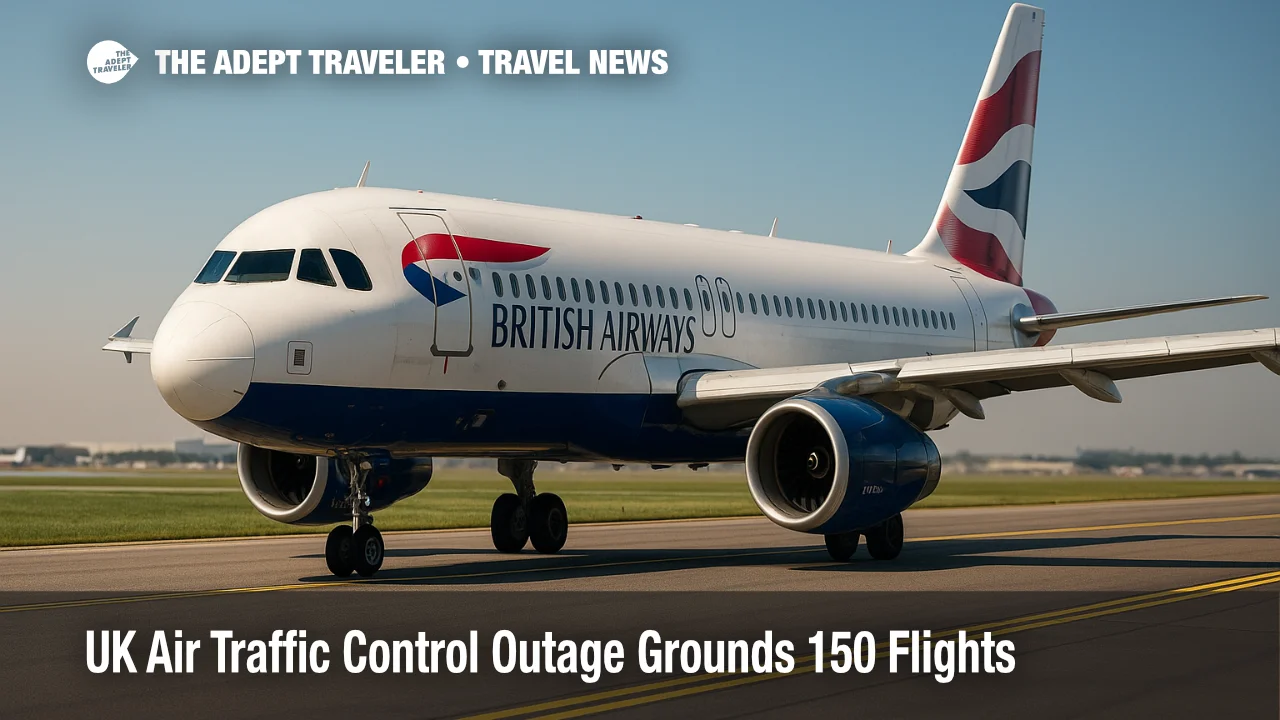UK Air Traffic Control Outage Grounds 150 Flights

A radar-related glitch at the National Air Traffic Service (NATS) Swanwick control center halted departures nationwide for 20 minutes on July 30, 2025, but ripple effects grounded or diverted more than 150 flights and left aircraft and crews badly out of position. Heathrow, Gatwick, Stansted, and Edinburgh spent Thursday clearing backlogs, while Transport Secretary Heidi Alexander warned travelers to expect multi-day disruption. Budget carrier Ryanair called for NATS CEO Martin Rolfe's resignation, and easyJet pressed for answers after the second major outage in two years. Under UK law, compensation is unlikely because air-traffic failures count as "extraordinary circumstances," but travelers still retain care and reimbursement rights.
Key Points
- Why it matters: Peak-summer schedules buckled, stranding tens of thousands of travelers.
- Radar fault forced a nationwide traffic rate cut for safety, grounding 150+ flights.
- Heathrow canceled ten more services Thursday as aircraft repositioning dragged on.
- Ryanair and easyJet criticised NATS leadership, citing a 2023 outage.
- Compensation unlikely, but airlines must refund or reroute and provide meals and lodging.
- Travel insurance with disruption cover remains the best fallback for extra costs.
Snapshot
Engineers restored the Swanwick radar feed within 20 minutes, yet clearing the queue proved far slower. At one stage British Airways trimmed its Heathrow departure rate from 45 to 32 flights per hour, while incoming aircraft entered holding patterns or diverted to Amsterdam and Paris. Cirium data showed 84 departures and 71 arrivals canceled on Wednesday alone, equal to roughly three percent of scheduled UK traffic. By Thursday morning systems were fully operational, but Heathrow still axed ten services and Gatwick warned of "knock-on delays." Airlines urged passengers to recheck itineraries, use mobile apps for rebooking, and arrive early in case of gate changes.
Background
NATS opened its highly automated Swanwick center in 2002 to manage southern UK airspace, but critics say resiliency lags rising traffic volumes. A flight-data-processing bug on the August 2023 bank-holiday weekend forced manual input of flight plans and disrupted some 700 000 passengers. A government-commissioned review later demanded stronger backup capacity and crisis drills. Wednesday's radar outage, though far shorter, rekindled doubts. Since privatization in 2001, NATS' majority ownership by airlines and pension funds has frequently drawn scrutiny whenever technical failures cascade into costly operational meltdowns. Passenger advocacy groups now press for stricter performance targets and transparent incident reporting.
Latest Developments
Radar Glitch at Swanwick Sparks Nationwide Delays
NATS said a "radar-related issue" obscured parts of its airspace picture, triggering an immediate traffic-rate reduction to maintain separation. Engineers isolated the fault, rebooted affected servers, and revalidated output before lifting restrictions. No evidence of cyber intrusion emerged, and the agency labeled the event an "isolated incident." Nevertheless, airspace demand peaked at the height of Europe's summer holiday rush, amplifying the fallout. Heathrow's ground operations team reported dozens of remote stands occupied by aircraft missing crews, complicating Thursday's push to normalcy. Gatwick and Stansted each logged more than 40 arrival holds during the disruption window.
Airlines Demand Accountability from NATS
Ryanair's corporate office blasted "yet another avoidable systems failure," calling on CEO Martin Rolfe to quit and urging regulators to impose financial penalties. easyJet's Chief Operating Officer David Morgan deemed the repeat breakdown "extremely disappointing" and requested a detailed root-cause briefing. British Airways stopped short of demanding resignations but confirmed it limited movements for over two hours and offered rebooking at no cost. Industry analysts note growing airline frustration with paying NATS service fees while shouldering the lion's share of delay costs, especially compensation vouchers, crew overtime, and hotel bills.
What Travelers Should Do Now
Passengers booked through the weekend should monitor flight-status alerts and allow extra buffer time at airports. Under UK261 rules airlines must provide meals, beverages, accommodation, and communication once delays pass two hours, even when compensation is off the table. Travelers lacking disruption cover can still claim reasonable expenses with receipts, but luxury items risk rejection. For longer-term guidance on rerouting and refunds, see our Europe Airport Strikes: Compensation and Re-Routing Guide. Comprehensive travel insurance remains the surest hedge against out-of-pocket losses from missed tours or prepaid hotels.
Analysis
Wednesday's short-lived radar failure underscores how even minute-scale faults can snarl tightly packed summer schedules. Modern flight operations rely on synchronized data streams-radar, transponder, and flight-plan feeds-to maintain safe separation. When any node falters, air-traffic managers cut capacity, and cascade effects propagate rapidly: gate congestion, crew duty-time expirations, missed connections, and aircraft trapped out of place. Airlines shoulder operating costs and reputational damage, so their impatience with NATS is unsurprising, yet replacing complex legacy infrastructure without service breaks poses formidable challenges. The 2023 outage spurred recommendations for redundant data centers and stress-testing, but implementation timelines stretch years. Wednesday's quick recovery hints at improved incident response, yet the residual havoc exposes the industry's limited slack. Regulators may face renewed pressure to mandate service-level guarantees backed by fines that fund passenger care. Travelers, meanwhile, must brace for sporadic disruption peaks and treat robust insurance and flexible itineraries as essential travel tools rather than optional extras.
Final Thoughts
The radar fault was fixed in minutes, but its aftershocks will ripple through UK timetables for days, reminding travelers that aviation's digital backbone remains vulnerable despite heavy safeguards. Until hardware redundancy and software resiliency catch up with surging demand, carrying disruption insurance, saving receipts, and building scheduling buffers remain prudent defenses against the next UK air traffic control outage.
